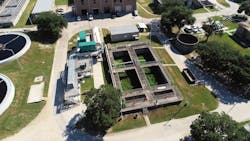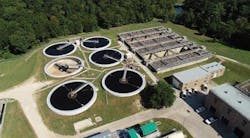Modifications Improve Sludge Digestion at Texas Plant
About the author:
Paul Wood, P.E., is a senior associate at Lockwood, Andrews & Newnam, Inc. (LAN), a national, planning, engineering and program management firm. He can be reached at [email protected].
Lockwood, Andrews & Newnam, Inc. (LAN), a national planning, engineering and program management firm, designed a comprehensive upgrade and rehabilitation project for the City of Conroe, Texas, Southwest Regional Wastewater Treatment Plant (Southwest WWTP). As part of the upgrade, modifications and improvements were made to the existing aerobic digestion process and dewatering system.
The plant has been operating since the mid-1970s and has had two prior plant expansions. It had been approximately twenty years since the last expansion, and most of the equipment in the plant had reached or exceeded its design operating life. As part of the last expansion, a new aerobic digester had been installed. Based on the size of the basin, and the two-stage design, it was calculated that there was an expected influent concentration to the digester of at least 4%. To achieve this concentration, the previous design had included gravity belt thickeners (GBTs). Unfortunately, the design included open channel flow for transportation of the thickened sludge to the two cells of the aerobic digester.
The operator had reported that when the unit was started up, the thickened solids failed to flow to the digesters. The GBTs were shut down and the thickening operations were never used after the initial attempt to operate. Fortunately, the plant had an abandoned 1.5 million gallons a day (mgd) contact stabilization plant that was put into service as a “second” stage digester, allowing them to meet their Class B solids requirements.
Decommissioned contact stabilization that was used as the “second stage” digester.
Plant Modifications for Sludge Digestion
Part of LAN’s evaluation for plant modifications was determining ways that energy consumption could be reduced. The old contact stabilization plant was piped to pull air from the blower building where the blowers were sized to deliver air to 20-foot deep aeration basins. These aeration basins were designed for the first expansion that replaced the obsolete 1.5 mgd plant. The contact stabilization plant was shallower, with a 12-foot depth. Pressurizing the air more than what was needed was an energy waste.
Additionally, the project team recognized that if solids could be thickened and delivered to the new aerobic digester at the 4% concentration, then the use of the “second” stage digester (the converted contact stabilization unit) could be entirely eliminated, thus eliminating the need for air associated with that unit.
The question remained, how to increase the solids concentrations of the waste sludge to the required 4% concentration? Fortunately, when the contact stabilization plant was abandoned, one unit existed that could be repurposed for the need. The existing clarifier was of sufficient diameter and depth that it could be easily converted to a gravity thickener. Batch flux tests were run to confirm that the sludge could be concentrated to at least 4%.
Piping was modified so that the waste sludge could be diverted to the new thickener. Minor repairs were made to the existing clarifier and a new scraper mechanism was installed. The existing sludge line was used as a host pipe and slip-lined with a smaller thickened sludge pipe. New double disc pumps were installed to convey the thickened sludge to the digester. These modifications allowed the aerobic digester to operate as intended without the use of the second stage digester for sludge digestion.
Other modifications were made to the aerobic digester piping. The existing piping was oversized, and there were concerns about the resulting low velocities at the anticipated belt press feed rates. New piping was run, and flow meters were installed. A derelict belt press was demolished and replaced, and the existing belt press was rebuilt to “like-new” conditions. New automatic liquid polymer systems were installed, and they independently feed either belt press. Polymer addition rate was automatically adjusted based on thickened sludge feed rate to the belt presses.
Aerial photo of the Conroe Southwest Regional Wastewater Treatment Facility (SWR WWTP) (Photo Credit: LAN)
Results of Aerobic Digestion Plan Implementation
The operators reported that the modifications improved ease of dewatering, and that polymer use per ton of dry solids decreased. Because many modifications were made to the plant, including conversion of the main train from conventional activated sludge to a biological nutrient removal (BNR) process, it’s hard to say that the modifications to the digester alone were responsible for the improvement in sludge digestion. Two improvements resulted from the overall plant modifications:
- Plant-wide energy use decreased by more than 25%; and
- Underflow concentration of the secondary clarifiers exceeded 1.2%.
With higher solids concentrations going into the thickener, and improved sludge characteristics from the BNR process, the gravity thickener has surpassed the results predicted by the batch flux curves.
The sludge characteristics were impacted by the addition of an anerobic selector zone when the plant was converted to a BNR process. The main train was designed as an AO process, but aeration control allows the oxic zone to almost completely denitrify. Filamentous bacteria are put at an environmental disadvantage and are essentially non-existent in the basins.
Additionally, the sludge has taken on a granular characteristic. Because no active means of retaining the granules has been undertaken, the granules remain quite small. Regardless, the settling characteristics are good, with little to no pin floc. The improved settling has allowed one or two of the six clarifiers to be routinely taken off-line for extended periods of time, even during wet weather events. Taking clarifiers out of service increases the overflow rate. This puts slower settling solids at a disadvantage, retaining faster settling solids. As long as the effluent total suspended solids limits are not exceeded, operating the plant with high clarifier overflow rates improves sludge settling rates. It is conjectured that the settling characteristic would improve further if another retention method, such as screening, is implemented and granules are allowed to grow to a larger size.
Aeration basins and clarifiers at SWR WWTP. Notice one clarifier and two aeration basins out of service. The plant has seen benefits by concentrating the loads and running the clarifiers at higher overflow rates. (Photo Credit: LAN)
Fitting Aeration Considerations into Sludge Digestion
One issue that has evolved with the increased solids concentration to the aerobic digester has been aeration. It is known that as solids concentrations go up, transfer efficiency decreases. The existing coarse bubble aeration system in the digesters was not considered for modifications or improvements at the time of the other upgrades due to budget constraints. At LAN’s recommendation, the operator has implemented periods when the aeration system is turned off so that the digester can denitrify, in keeping with the energy savings objectives. However, the coarse bubble system has had difficulty in always providing the oxygen needed.
Two possible improvements have been discussed with the owner for consideration for future implementation. One is to decouple mixing and aeration by installing mechanical mixers and using medium-to-fine bubble diffusers. Typically, the use of fine bubble diffusers is not considered in aerobic digesters with high solids concentrations due to the coalescence of the bubbles. However, if mechanical mixing can keep the shear high enough, the tendency to coalesce may be partially offset, at least long enough to improve the transfer efficiency.
Another possible improvement would be to supersaturate the incoming thickened sludge flow with oxygen. Because only endogenous respiration is occurring, the oxygen demand is greatly reduced (compared to the main train). This super saturation might be possible using conventional wastewater equipment typically used for hydrogen sulfide treatment in collection systems or using nanobubble generators.
The use of either of these technologies would require some care. Some nanobubble generators also generate microbubbles. Nanobubbles do not rise, as Brownian forces overcome buoyant forces at the nanobubble scale. Microbubbles do rise and are used in flotation equipment. Supersaturation may also lower the pH of the digester as carbon dioxide stripping is reduced. Those familiar with Unox process will recognize low pH as a characteristic of that process.


